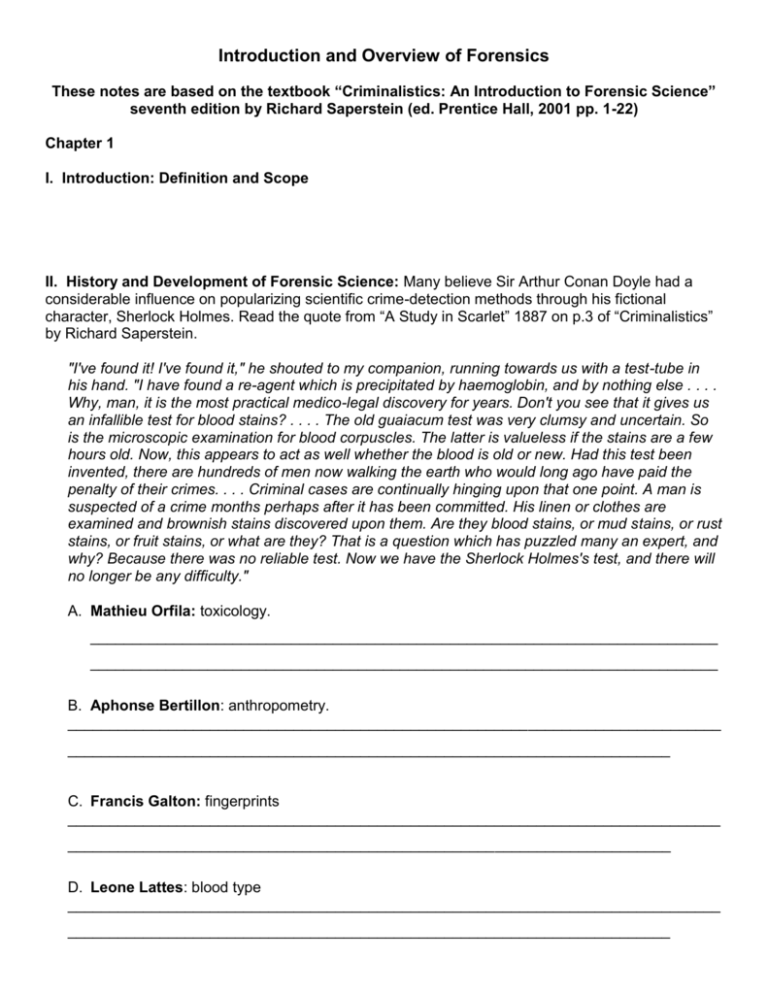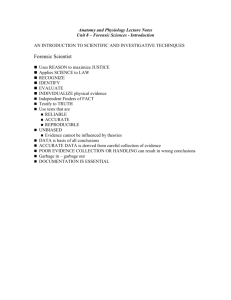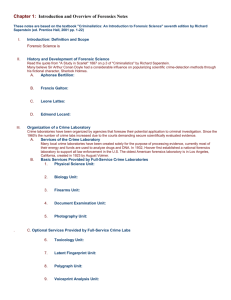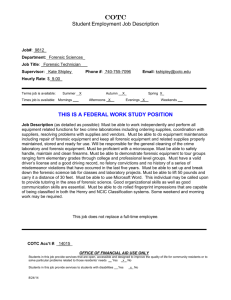Forensics Introduction notes blanks
advertisement

Introduction and Overview of Forensics These notes are based on the textbook “Criminalistics: An Introduction to Forensic Science” seventh edition by Richard Saperstein (ed. Prentice Hall, 2001 pp. 1-22) Chapter 1 I. Introduction: Definition and Scope II. History and Development of Forensic Science: Many believe Sir Arthur Conan Doyle had a considerable influence on popularizing scientific crime-detection methods through his fictional character, Sherlock Holmes. Read the quote from “A Study in Scarlet” 1887 on p.3 of “Criminalistics” by Richard Saperstein. "I've found it! I've found it," he shouted to my companion, running towards us with a test-tube in his hand. "I have found a re-agent which is precipitated by haemoglobin, and by nothing else . . . . Why, man, it is the most practical medico-legal discovery for years. Don't you see that it gives us an infallible test for blood stains? . . . . The old guaiacum test was very clumsy and uncertain. So is the microscopic examination for blood corpuscles. The latter is valueless if the stains are a few hours old. Now, this appears to act as well whether the blood is old or new. Had this test been invented, there are hundreds of men now walking the earth who would long ago have paid the penalty of their crimes. . . . Criminal cases are continually hinging upon that one point. A man is suspected of a crime months perhaps after it has been committed. His linen or clothes are examined and brownish stains discovered upon them. Are they blood stains, or mud stains, or rust stains, or fruit stains, or what are they? That is a question which has puzzled many an expert, and why? Because there was no reliable test. Now we have the Sherlock Holmes's test, and there will no longer be any difficulty." A. Mathieu Orfila: toxicology. ___________________________________________________________________________ ___________________________________________________________________________ B. Aphonse Bertillon: anthropometry. ______________________________________________________________________________ ________________________________________________________________________ C. Francis Galton: fingerprints ______________________________________________________________________________ ________________________________________________________________________ D. Leone Lattes: blood type ______________________________________________________________________________ ________________________________________________________________________ E. Calvin Goddard: ______________________________________________________________________________ ________________________________________________________________________ F. Albert S. Osborn: document analysis ______________________________________________________________________________ ________________________________________________________________________ G. Hans Gross: first forensic journal, “Kriminologie”. ______________________________________________________________________________ ________________________________________________________________________ H. Edmond Locard: Locard’s exchange principle ______________________________________________________________________________ ________________________________________________________________________ III. Organization of a Crime Laboratory I. Services of the Crime Laboratory ______________________________________________________________________________ ________________________________________________________________________ A. Basic Services Provided by Full-Service Crime Laboratories 1. Physical Science Unit: ________________________________________________ _____________________________________________________________________ 2. Biology Unit: ________________________________________________ _____________________________________________________________________ 3. Firearms Unit: ________________________________________________ 4. DocumentExaminationUnit:______________________________________________ _______________________________________________________________________ 5. Photography Unit: ________________________________________________ _____________________________________________________________________ B. Optional Services Provided by Full-Service Crime Labs 1. Toxicology Unit: ________________________________________________ 2. Latent Fingerprint Unit: ________________________________________________ _____________________________________________________________________ 2. Polygraph Unit: _____________________________________________________ _______________________________________________________________________ 3. Voiceprint Analysis Unit: _____________________________________________________ _______________________________________________________________________ 4. Evidence-Collection Unit: ____________________________________________________ ________________________________________________________________ C. The Functions of The Forensic Scientist 1. Analysis of Physical Evidence: ____________________________________________ ___________________________________________________________________________ 2. Expert witness: ____________________________________________ ___________________________________________________________________________ 3. Specially trained evidence collection technicians: ________________________________________________________________________ _______________________________________________________________________ D. Other Forensic Science Services Death can be classified into five different categories: natural death, homicide, suicide, accident or undetermined manner of death. 1. Forensic Pathology: a. Rigor mortis. ____________________________________________ b. Livor mortis: ____________________________________________ c. Algor mortis: ____________________________________________ E. Forensic Anthropology: ____________________________________________ F. Forensic Entomology ____________________________________________ G. Forensic Psychiatry ____________________________________________ H. Forensic Odontology: ____________________________________________ I. Forensic Engineering ____________________________________________ J. Forensic Analysis also can include organic and inorganic analytical techniques. 1. Organic analysis ____________________________________________ _____________________________________________________________ 2. Inorganic analysis ____________________________________________ _____________________________________________________________ References: Saperstein, Richard, “Criminalistics: An Introduction to Forensic Science,” pp. 1-22. Prentice Hall, Inc., Upper Saddle, NJ 07458, 2001. ISBN 0-13-013827-4 (textbook with lots of background information and figures)








